
| Historical Information |
News and Notes from the Pax World |
The Pax Film Project |
The Histand Gift Project |
Stories of Service |
Needs & Opportunities |
Photos and Images |
 |
Pax - Mennonite Central Committee | ||||||
|
News and Notes
Click the links below to go to the article on this page.
My Pax Experience by Marlin GerberWith the exception of being out of Ohio two or three times, my first taste of travel was in 1955 as a 20 year old after attending two years at Bluffton College. My parents drove me to Akron, PA, to join the PAX program with 26 other conscientious objectors. Our mission was to build housing for homeless WWII refugees: and as General Hershey advised us, "you are representing America abroad." He came to the orientation and spoke with us for several hours. Many of the experiences during the next three years were ordinary and expected, some were unexpected and challenging, and still others fun and educational. It didn't take long to become acquainted with most of the other boys, some of whom I'd live and work with the entire three years. My encounter with a 16 year old German youth, Fritz Moeller, on the old troop ship 'Groote Beer" taking us to Europe was fun. We still email and have visited each other several times. Together with two Dutch youth, we tossed a note within a bottle into the Atlantic which we later received in the mail from a French person who found it on a beach in France. (More on Fritz elsewhere.) Our Pax group viewed a volunteer group working in Holland, stopped at the Mennonite Central Committee (MCC) office in Amsterdam, stopped for a two day orientation in the Frankfurt office, and enjoyed the remainder of the journey through the countryside to Backnang in southern Germany on a leased bus with driver. With us was Pastor Duerkson, who had taught music in a Mennonite college, so we had practiced lots of singing on the boat, and sang at the Pax orientation in Backnang as well. Working in construction with German workers at that site, I quickly developed skills learned in the German course I took in college. The language in southern Germany is a low German, vaguely comparable to the high (correct) German language of the north and taught in textbooks. Our main staple for meals was the famous MCC canned beef that is donated and canned in rural America, lots of potatoes, vegetables, fresh baked bread and various US dept of Agriculture canned butter, cheese, apple butter, etc. (see chapter on MCC canned meat) It was determined that I'd begin work in the plastering trade at Backnang. I began to plaster the outside of the block condo type buildings, then continued in the basements and worked upwards into areas requiring more skill. About 9 AM each working morning one of the cooks would bring freshly baked bread from the local bakery, hot chocolate and generous chunks of surplus U.S. department of agriculture cheese which we called "second breakfast." During this 15 minute rest us Pax boys would receive our mail and entertain ourselves by trying to out-do each other in lifting weights. Attention was focused on the hand-made barbell which was a heavy piece of pipe with a bucket sized chunk of concrete attached to each end. I was pretty good at this activity! The only personal washing facility we had was a washbasin in a 4 x 4 bathroom with 8 guys in an apartment, but there were approximately 20 pax boys living in the entire unit. Friday was "bath night" so after supper, we'd all pile into the 1955 VW bus, or onto our bicycles, drive into town and take our weekly bath at the public bath house. One didn't want to breathe too deeply on the way into town if riding in the bus! The work week ended 'Saturday noon so we had that afternoon off plus Sunday.--except for me, when I had to prepare for the German youth-Pax boy choir practice on Sunday evenings. Other activities during the week generally included Bible study on Wednesdays, basketball on Thursdays, and occasionaly a few of us would get invited into homes for a meal. Recently several people put together a DVD of the MCC Pax program. The program started in 1952 and ended in the mid seventies with over 1,200 young men working in more than a few countries. It was shown on National TV. At the end of the German segment, I was caught going into an outhouse. Acouple Paxers pushed the outhouse over onto the door with me inside. I quickly kicked my way out through the roof to chase the pranksters but didn't catch them! These DVDs can be ordered at the MCC media center in Akron, PA. I forgot to mention we worked as much as we could with the youth in the community, some of which we still maintain close connections. I helped to distribute Christmas bundles sent there by our congregations back home. On our days off we bicycled to notable cities such as Rothenburg, Schwabish Hall, Heidlelberg, and Schorndorf. Once all of us toured Switzerland in two VW buses to visit historical Mennonite landmarks such as the Langnau Mennonite church and Zurich. Because not much work could be accomplished in freezing weather, our unit joined other Pax workers on a 10 day guided trip to the Holy Land at our own expense. I remember creating some postcard type Christmas greetings to send to my friends back home, which generated some monies to help with my trip, I remember Christmastime as a youngster feeling jubilation in role playing scenes of wise men who trekked to Bethlehem to celebrate Christ’s birth. Now at age 21, I relived this memory in visiting the Holy Land in person with my European PAX colleagues on a long Christmas break from the workplaces around Europe. Our taxi cab caravan of 50 MCC workers wound over and around the Jordanian hills the wise men crossed with their gifts of gold, frankincense and myrrh. After stooping to enter the low door to the Church of Nativity in Bethlehem, we descended twenty or more steep stone steps to view the spot where tradition says Christ was born. The Mennonite church back in Ohio where I grew up provided me a program of Sunday school education plus I had just finished a Bluffton College course in New Testament history. So I was invigorated and enlightened on this historical Holy Land tour. One slight disappointment was an unresolved declaration of where the head of John the Baptist’s head lies. One tradition says it is in Damascus, Syria and one says it lies in Jerusalem. Other discrepancies exist concerning historical sites and events in this country. As we walked where Christ walked, I was humbled to walk in Cana where Christ performed his first miracle, turning water into wine. I was excited to tread ruins of Capernum where Christ first read from the Holy Scriptures. And I enjoyed a meditation our group experienced on the banks of the Sea of Galilee where Christ called his disciples The narrow cobble stone streets of Nazareth led us to artisan shops where tin smiths, crafts people, and carpenters practiced their trade. At one end of a street was Mary’s well near a large Tabernacle. One experience that connected earlier studies of mine with the here and now for me was touching the huge living olive trees in the Garden of Gethsemane where Christ was betrayed by Judas. Gethsemane is immediately across the valley from the Dome of the Rock in Jerusalem. The Dome of the Rock built in the 7Th century AD is a Muslim shrine and is the oldest Islamic monument that stands today--and one of the most beautiful. Most Jews believe the rock upon which it stands is the very place where Abraham prepared to sacrifice Isaac. The magnificent golden dome that crowns the building was originally made of gold, but was replaced with copper and then aluminum. The aluminum is now covered with gold leaf. Other memorable experiences for me were: When I took communion with my tour group in an upper room; when I walked “The Way of the Cross” leading to Golgotha on the outskirts of Jerusalem, and finally when I explored the area where Christ ascended into heaven Backnang was known as "the city of Gerbers" (my namesake) It was also known as a center for leather working. I have a beautiful wooden plate enhanced with a carving motif done by a gentleman in the city. Living there for 13 months was a rewarding time, but now it was time to move on. PAX director Wiebe needed someone to organize a Christmas pagent for the youth in Bielefeld, another Pax unit in the north. This I would do in addition to plaster. I took two beautiful Fall days to ride my moped there and slept at a youth hostel in Bohn, the former capital of Germany. It was quite an adventure exploring the back country roads, seeing portions of the bombed out city of Koblenz, eating my lunch on the banks of the Rhine River, etc. The unit leader in Bielefeld was Walter "Poncho" Schmucker. In November, it was fun helping to plan the presentation of our AmericanThanksgiving history to the German youth. In the Fall I located a cider mill and used a moped to haul a 5 gallon flask of cider to our unit. In December, on a cold winter night, a number of Paxers visited a refugee shelter, sharing poems, singing, and distributing Christmas gifts. These refugees had lived in camps similar to the one we visited for eleven years since the end of WWII. These refugees lost their homes and all their possessions. People who needed to tell their stories--and we listened. We gave treats to the children, admired and bought some hand crafts from the women, and sang songs. These were heart wrenching times. Marlin Gerber ‘Pax Service: An Alternative to War’ honored
HARRISONBURG, VA – Pax Service: An Alternative to War, produced by Third Way Media, was honored recently for its depiction of veterans of peacemaking through service to humanity. The Association of Marketing and Communication Professionals (AMCP) Videographer Awards recognized the 2008 Mennonite documentary with an Award of Distinction. The program features the story of an alternative service program from the 1950’s to 1975 which sent 1200 young men around the world, serving their country and their faith through humanitarian projects. It premiered on Hallmark Channel, November 23, 2008. The Videographer Awards is an international competition designed to recognize excellence in video productions, TV commercials/news/programs and new media. The mission of the Videographer Awards is to provide meaningful recognition from the AMCP, an organization that consists of several thousand marketing, communication and video professionals.
Pax Service began as a way to address the housing crisis in Europe after the destruction of World War II, and was one of the alternative service programs available to conscientious objectors when the U.S. began a draft in 1950 for the Korean War (and subsequent Cold War and Vietnam War eras). The TV show covers work in Germany, Austria, Greece, Paraguay and Congo.
Salzburg, Austria, PAX Reunion Held at The Welcoming Place.
The Salzburg PAX unit reunion was held September 10-13, 2009, at the MCC Welcoming Place. Twenty nine attended, including spouses. The group stayed in the excellent accommodations of the Africa and the America Houses on campus. Persons attending had traveled across the U.S., Canada, and Germany to attend this event. The Mennonite Central Committee PAX Program (an alternative to Military Service), built six multi-family houses and a church for an Anabaptist German speaking group related to Apostolics, refugees from the former Yugoslavia, primarily Serbia. Paxmen built these houses in the early 1960’s just outside Salzburg, Austria, close to Hallein. The previous reunion took place in Asilomar, Monterey, California. The group meets every three years at a location decided by a committee. In two years 2011, however, they may hold the reunion in Austria to commemorate the 50th anniversary of the beginning of the project. The customary three year reunion site is still being investigated by a new committee.
This year’s committee consisted of Lowell and Verna Bender, of Bittinger, Maryland; Ervie and Mary Glick of Harrisonburg, Virginia, and Dick and Cathy Boshart of Lebanon, Pennsylvania. The agenda of the Akron reunion included daily gatherings with PAXers sharing recent life experiences, motivations for Christian Service as PAX molded their lives, and common peace concerns in the world. Cultural events included a tour of the MCC Material Resource Center, a visit to the Ten Thousand Villages store, an Amish Country Tour lead by Faye Irene Landis (wife of PAXer Bob Landis), a meal in an Amish home, and performances at the Sight and Sound Theaters. On Saturday evening other local PAXers were invited to attend and share a joint meal of Austrian Bratwurst sandwiches and fixings, with the local PAXers bringing Pennsylvania Dutch desserts. The group then met together with 52 present. Following introductions, they shared their PAX location and years of service and the effects it made on their lives. Germany, Austria, Greece, Nepal, Morroco, and Algeria were places of service. Sunday morning the attendees participated in a worship service led by moderator Lowell Bender and Ervie Glick, song leader. The devotional meditation was presented by Wayne Yoder. His wife Linda sang a supporting solo. Mennonite Central Committee Africa representative, Bruce Campbell-Janz gave an update of current MCC work in various locations in the world, He also gave information about a new program called “SEED” which provides service opportunities for persons who will commit to two years overseas. The reunion group decided to donate money to the SEED program to encourage young people to choose this challenging and rewarding service.
Observations at World Conference and Following By Clair BrennemanIt was very rewarding for me to return to Paraguay for MWC and to observe the progress that has been made following my two years of service 54 years ago. The Mennonites have not only progressed themselves, but more meaningful to me was the way they have reached out to the Paraguayans [most of Spanish heritage]and indigenous people in terms of education, health care, welfare and evangelism. Having worked on the Trans Chaco Highway, it was a highlight to travel the highway built by MCC personnel. It not only provides a market road for the Mennonites but for the Paraguayan ranchers. We heard several comments that if the road had not been built, the existence of the Mennonite colonies would be questionable today. Following my presentation at the conference a number of people came forward and expressed gratitude for what the PAX boys had done for their country. One person told me that his Dad, Jacob Penner, used to cook for PAX boys who were building the highway. Following the conference, we traveled to the Chaco on the Trans Chaco highway. We saw semis coming to Asuncion, the capital city, with loads of beef cattle, dairy products and other products from the Mennonite colonies. On one occasion while stopping enroute, I observed dairy products on display racks in a store. They all indicated the product was manufactured in “Colonia Menonita". To build the Trans Chaco highway was not easy task. There was the rainy season, swamp areas, jungle, the difficulty in obtaining parts for machines, intense heat, and the morale was not always positive. It is rewarding to look back and see the accomplishment and forget some of the struggles we went through. Parguayan officials questioned the possibility of such a task. But MCC moved forward and followed the progress of the highway to its completion. I am grateful to the Harry Harder family who left their comfortable home in Mountain Lake, Minnesota and moved to Paraguay to be in charge of the highway and the PAX boys. Harry was engineer for the project. Ann, his wife, an excellent support person, gave home schooling to their children, Martin and Margaret. They were missionaries in a non-traditional way. Although the Trans Chaco highway was a major project of MCC in Paraguay, may we not forget other PAX boys who served there. Inner colony roads were built by PAX prior to the Trans Chaco to connect villages within a colony and to connect colonies with each other. Those PAX boys were under the leadership of Vern Buller of Bloomfield, Montana, who with his family lived in the Chaco during construction of those roads. PAX boys also served with MCC in agricultural extension, experimental farms, etc I am very grateful for my experience in Paraguay, and affirm the work and mission of MCC.
Pax Events at Assembly 15 of Mennonite World Conference – Asuncion, Paraguay – July 14 – 19, 2009. A Report with Comments.
|
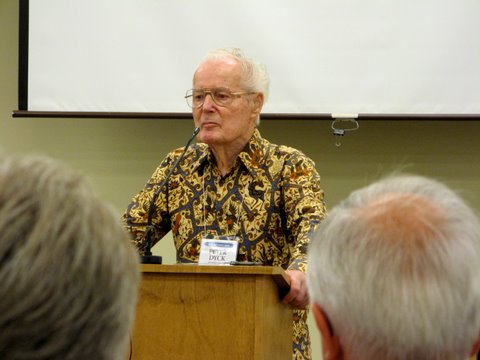 |
Peter Dyck |
Oopah! Members of former PAX teams in Greece met for a reunion at the MCC Welcoming Place in Akron, PA, June 5-8, 2008. Coming from California, Oregon, Florida, Canada, New York, Kansas, and other distant states to meet with local members, the group of 100 included spouses and children. Peter Dyck, who was MCC’s director of European and North African work during that time, was a speaker and guest. Orville Schmidt presented a video of a Greek PAX tour in 2004.
The PAX program began in Greece in 1952 and ended formally in 1972. Projects for agricultural development and research, fruit and vegetable canning, and building of farm buildings for demonstration and education were undertaken in northern Greece and on the island of Crete.
 |
| Left to right: Kenneth Davis, Omar and Sara Lapp, LaMar and Kathryn Stauffer, Lois Martin, Lydia and Menno Ringenberg-Riehl, Dale Weaver, and Dan Bert |
Local members organized the reunion event. Introductions and reminiscences began the program. On Friday a tour of Lancaster County included visits to MCC’s Material Resources Center and Ten Thousand Villages’ warehouse, and the Mennonite Information Center with the Hebrew Tabernacle. Dinner at an Amish home was a highlight of the day.
Saturday’s visit to the Greek Orthodox Church of the Annunciation, Lancaster, PA, had special meaning as Father Alexander Veronis briefly explained the icons decorating the church and distinctive features of the Greek Orthodox faith. Young people from the church, dressed in traditional costumes, exhibited their Greek dancing skills for the enjoyment of the group.
Also on Saturday’s program, after Peter Dyck related the story of PAX’s beginning, Ron Flaming and Chris Landes brought the group up to date on MCC activities and issues.
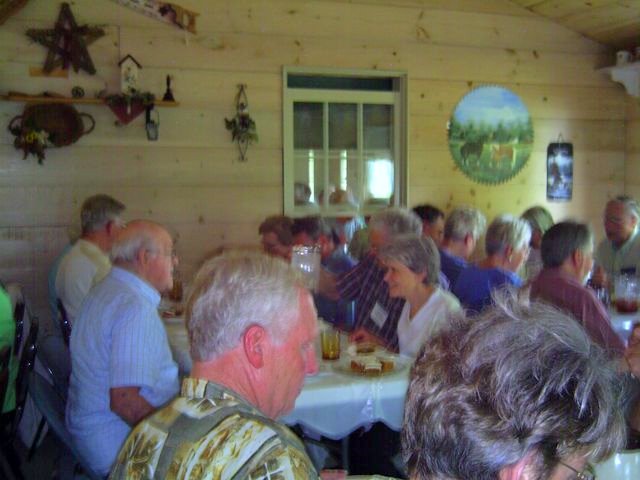 |
| Group dinner at an Amish farm in Lancaster County Photo by Althea Philips |
Joining the Greek Paxers for the Sunday worship service were students at MCC’s Summer Peace Building Institute. After Ken Sensenig’s sermon, Sikhylulekile Mkandla from Zimbabwe responded with a few words about forgiveness and peace in her country. Many of the group committed to pray for the leaders and people of Zimbabwe for changes of heart that would alleviate the suffering there.
For further information contact Althea Philips at altengle@yahoo.com or Omar Lapp at omarsara@epix.net
Fifty six years ago a number of young men from various Mennonite communities met at Akron to launch a new program called Pax .If this experiment proved successful the program would continue.. The Pax program did go on for twenty five years. From Oct. 8-11 2007 many of these same men reunited at Camp Amigo near Sturgis Mi., this time not as strangers but more like brothers because of the bonding that occurred in those Pax experiences.
Attendees were Menno Gaeddert who was unit leader at Espelkamp,Marvin Gehring,Roger Hochstetler Homer Kolb.Jay Lehman, John Mann, Richard Oberholtzer, Luke Rhodes, Arnold Roth, Albert Roupp, Richard Rush, Willard Stucky, Robert Swartz, Carl E Yoder, Melvin Helmuth and William Yoder. Frank Heidebrecht from Hamburg Germany showed pictures of his work of sending supplies into Kosovo. Franks' family was one of the families that got one of the Espelkamp houses and he caught the Pax spirit. Also present was Anna Holdeman and her two daughters. Anna is the widow of Ivan Holdeman who was one of our group.
Richard Rush
A PAX committee of Al Keim, Orville Schmidt, Arlo Kasper, Arlin Hunsberger and Cal Redekop has several projects under way--the Pax Film Project; the Histand Gift; and most recently the creation by the Mennonite Bible School near Basle of a “peace walk which features among other things a fountain rededicated to PAX.
In July the Backnang, Germany community held a 50th anniversary celebration for the construction of their church house by PAX men. A number of PAX men attended.
I’d like to invite a 1000 word essay on the 50th anniversary event of the Enkenbach siedlung in 2003. At the invitation of the siedlung and the leadership of Orville Schmidt more than 40 men and their spouses attended the event.
Please send in (Webmaster@PaxMCC.com) stories, recollections, current experiences, thoughts and reflections. All will be published by this web page.
We plan to continue with a international working Camp on the Summer 2008 in order to continue as planned our Peace path (29th of June to 5 of July 2008). We have a little committee here at Bienenberg seeking to find good Ideas, joint-ventures with groups, artists who are able to contribute
A description of the 1st station on the Peace Path, "the Pax Fountain" or as Claude calls it, "The Fountain of Creation", that was constructed "in honor of the people who were involved with the Pax program. The paragraph below regarding Hansruedy Rufenacht gives credit to one of their maintenance workers who designed the "Pax Fountain".
The name of the maintenance man (also an artist) here at Bienenberg is Hansruedy Rufenacht. He planned the first concept, and the young people (in the summer work camp who constructed the fountain) contributed to the more detailed arrangement.
From left to right: Michel Steiger/ from Schänzli Church, Switzerland ; Katharina Hofmann/ from Mennonite Brethren Church Wasservurg/ Germany; Tabea Rediger/ from Schänzli Church, Switzerland; Rahel Saegesser/from Schänzli Church, Switzerland; Hansruedi Ruefenacht, maintenance director and artist, Bienenberg; Switzerland; his wife Irma Ruefenacht who works in the kitchen, Bienenberg; Delphine Kreis/from Mennonite Church Alsace/France; Claude Baecher and Heike Geist, both teachers and academic directors at Bienenberg; Nico Abert, Mennonite Church/France; Jonas Wurster/from from Schänzli Church, Switzerland |
Workers and students who took part in the first Peace Path work Camp at Bienenberg. |
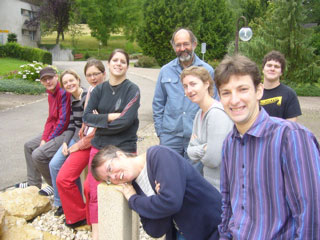 |
2 We will place a Plaque/Plate that mentions in French, German, English “In thankful remembrance of the work of the MCC Pax Program, an alternative to participation in the military from 1951 to 1976 in USA” (in french it would give something like “Pour l’oeuvre du programme Pax Programm du MCC, comme solution de remplacement à la participation militaire aux USA entre 1951 et 1976, avec reconnaissance”) |
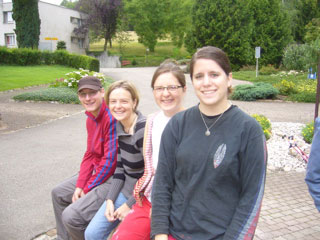 |
3 Michel Steiger/ from Schänzli Church; Katharina Hofmann/ from Mennonite Brethren Church Wasservurg; Tabea Rediger/ from Schänzli Church; Rahel Saegesser/from Schänzli Church. |
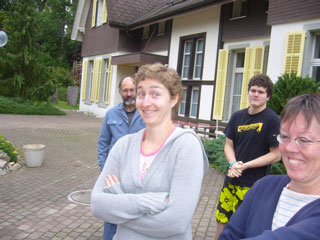 |
4 from left to right:Hansruedi Ruefenacht, maintenance director and artist, Bienenberg; Delphine Kreis/from Mennonite Church Alsace;Jonas Wurster/from from Schänzli Church; Heike Geist, teacher at Bienenberg/CH. |
* that it expresses thankfulness for God’s magnificent work of Creation * The seven pillars symbolize the seven days of creation (we have also placed recently two doves, one on the seventh pillar and one on a stone beside, symbolizing at the same time the spirit and peace) * The stones are from the Jura region (the region in which Bienenberg) is located . The Idea is that "out of the wilderness comes life". * In the middle is a spring of Water (there is also light on it in the evening). The water moves when there is a little bit of wind. It symbolizes the work of God’s Spirit bringing life where there was no (more) Life before. Here is the symbolism of what the PAX program brought to many places of the earth "In the Name of Christ"... And we are thankful for the credibility of the Gospel that accompanied these deeds in a world of violence, destruction and sin. * We have also placed some fossils, that is petrified former Life, in order to show that each generation must open itself to the work of the Spirit of God in order to truly stay alive. |
The symbolism of the fountain of creation (and also somehow “new-creation”)
|
 |
6 Hansruedi and Jonas are preparing the location where the Pax Fountain will be installed. |
 |
7 Tabea is doing some landscaping around the Pax Fountain |
 |
4578
Behind the Pax Fountain: Claude Baecher, teacher at Bienenberg and former Pax Boy Walter Schmucker |
 |
4584 Walter Schmucker is presenting the check, contributed by 57 former Pax men toward the construction of the Peace Path and the Pax Fountain |
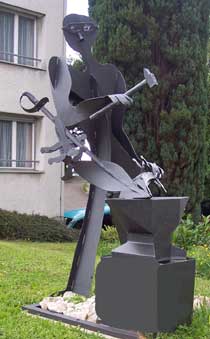 |
4586 A French artist, Bernard Egly has donated the iron figure; "He will judge between the nations and will settle disputes for many peoples. They will beat their swords into ploughshares and their spears into pruning hooks. Nation will not take up sword against nation, nor will they train for war any more." Isa 2:4 |
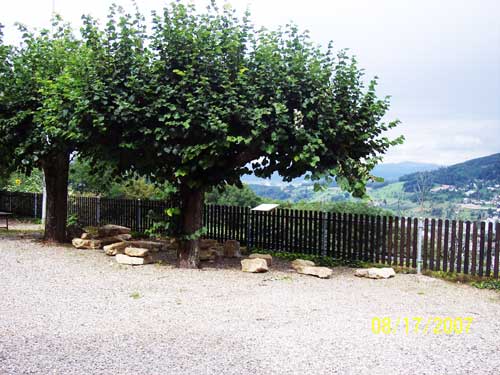 |
4600 Stumbling stones: to make guests and poeple think about war and peace we give some instructional information about current wars in Europe and around the world. |
Bienenberg Peace Path Project
At a time when the world seems to be in constant turmoil with violence and war being the primary way nations try to settle conflicts, it seems appropriate to establish examples of other ways to solve differences. The Theological Seminary Bienenberg (TSB), founded in 1950 as The European Mennonite Bible School by members of the Mennonite churches of France, Germany and Switzerland was also supported by MCC. And so, when a request came to former PAXers for assistance to establish a PEACE PATH at this location many responded. A total of 56 former PAX related persons contributed $5,200 that will be used to assist in establishing 18 sites along the Peace Path on the Bienenberg campus, the first of which is a fountain established to commemorate the MCC PAX program, an alternative to participation in the military from 1951 to 1976. In August, Walter Schmucker, PAX treasurer, presented a check for $5,200 to Seminary Director: Dr Claude Baecher (baecher@bienenberg.ch) and Undergraduate Programme Administrator and Director of School of Discipleship: Heike Geist (hgeist@bienenberg.ch)
The “PAX Fountain” was completed in July by a small work camp that included one person from Germany, two from France and 4 from Switzerland who worked along with Bienenberg staff members. Various stations along the Peace Path will eventually represent “Creation”, “The Fall”, “Redemption”, and “Hope”. The seven progressively higher stones behind the PAX Fountain represent the seven days of creation. Two other completed stations along the Peace Path include a group of “stumble stones” and a metal sculpture turning swords into plowshares.
EXPERIENCING 50 YEARS SINCE THE BEGINNING OF THE BECHTERDISSEN GEMEINDEIn the summer of 2006 I received, as many of the Bechterdissen PAX boys did, a letter inviting us to come to Bechterdissen and to be a part of the 50 year celebration. I put the letter aside with out much further thought. Earlier in the year some relatives had asked if I would take a group to Germany. As the plans for that trip were being made I kept Bechterdissen in the back of my mind. We had planned to go to Germany the beginning of Sept. and I thought I would visit Bechterdissen after the trip with the relatives. I communicated with Heini he asked if I could come earlier and help celebrate the 50 year celebration. So I changed my visit from the end of my trip to the beginning and booked a flight for August 28 arriving there on the 29th. I also wanted to leave the following Sunday morning to meet my relatives. I told Heine about my planes and soon received a call asking if I could possibly come so I would be there on the 27th which was a Sunday or Sept 2. Sundays were the most important time because more people would be there. So I changed my flight and left here on Friday the 25th and arrived in Germany the 26th The celebration went from Sunday to Sunday. The first Sunday Peter Huebert spoke and the choir sang. And in the evening there were interviews with people who were involved with establishing and planning the Gemeinde . Monday was open. There was no meeting. Tuesday evening was a program by the various choirs. Wednesday there was a breakfast for the retired “Senioren” people with activities afternoon and a slide show in the evening. Wednesday they had a breakfast for the women and in the evening they had personal testimonies about what God did in your life (the first time for sharing like this). Friday evening was praise worship young people style with a group “Guido Baltes and Band” (also a first). Saturday was a fun and food time with a church picnic, and Sunday there was a guest speaker Dr. Bernhard Ott from the Schweiz with a gemeinsames Mittagessen. That was the activities for the week. I was there for the first Sunday but left to go to Frankfurt the following Sunday morning so I missed the last day. The church was quite full most of the time. I think they have about 700+ members. I stayed with Karen and Heinrich Tyart, their house is right behind the church. I had met them about ten years earlier and Daniel their son had spent two weeks with us when he was in the USA. So we didn’t have to get acquainted but were able to continue were we left off ten years ago. Heini of course took good care of me also. Heini is also good friends with the Tyarts so they worked together to make me feel at home. Heini had me over several days at his apartment in Bad Salzufen. He is a very good cook and we spend time visiting the town, swimming in the spa pools and just sharing. As I think most of us know Heini was a bright light in our Bechterdissen experience and I am really blessed to have him as a friend and a Christian brother. We shared, reminisced, some times wept together. I met and spoke with many others in the church: the pastor, others in leadership and others. I visited also with Wilfred Regier and his wife. Wilfred doesn’t look any older than when we worked together 50 years ago. I met for the first time Fritz Wedler and his wife, in fact I went with the Tyarts to their house for “Kaffee und Kuchen” and what a nice couple they are. Some of you probably worked with him. I was disappointed I didn’t get to see Lothar Teuchert and Rudy Schultz. I have such good memories working with both of them. The young people, of course, didn’t experience the PAX era but I did speak with some of them and it was interesting to find lots of similarities with young people here in the states. They as most young people are groping for their identity and Daniel Tyart is working with them trying to give them guidance and direction. Sunday evening I was able to speak on behalf of the PAX boys who worked in Bechterdissen. It was a walk through the history of the Bechterdissen Gemeinde. Various people still living, who had a part in bringing the community together, were brought up on stage and interviewed and asked questions. I sat and listened to stories I had not heard before about the work that was put into this project. We all know about the paper work necessary to do any thing in Germany and these were stories about the beginning. When it came time for me to go on stage and be interviewed I walked up and the people began to clap and I felt all the appreciation for all the work that you all gave so freely and joyfully. I felt like this appreciation was not for me, I only did a small part, and I knew I needed to share this gratitude with all of you who contributed. I felt so much gratitude I could have wept. It was genuine and real and I wish all of you could have been there to feel the appreciation. I shared about how I felt I was giving two years of my life and receiving almost no money for doing it. I sorta felt a little selfrighteous about it back in the 50’s. I shared I was excited about the adventure and seeing Europe and I wasn’t aware what God was doing with me and with the people in Bechterdissen. And then later after I returned home I realized how little I really gave and how much I received. I shared that the experience changed my life. It enlarged my world. I experienced real Christians in Germany and I knew God was much bigger than I could have imagined. That was the essence of my interview and I trust and believe you would have said some thing similar. That is a birds eye view of what went on during that week of celebration and thank God I was able to represent you and I hope you felt like you were there with me.
|
It is possible to view more information about the Peace Path on a power point website at: http://www.bienenberg.ch/en/home/index.php |
| ©2006 Pax MCC | About Us |
• | Contact Us |
• | Home Page |
• | PAX MCC Blog site |
• | Sign the Guest Book |
• | Contact Webmaster |
• | MCC Website |